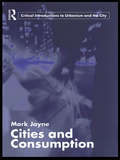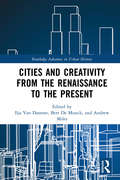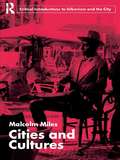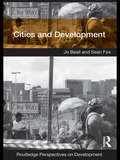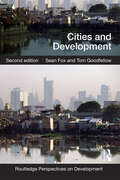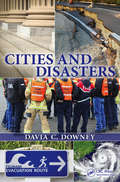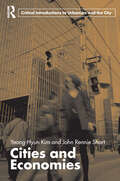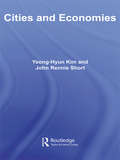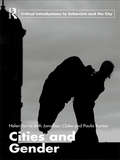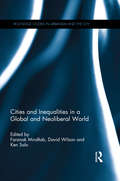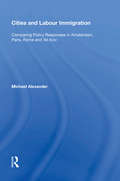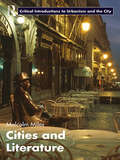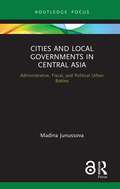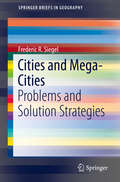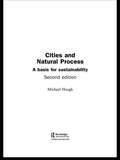- Table View
- List View
Cities and Consumption (Routledge Critical Introductions to Urbanism and the City)
by Mark JayneIn investigating the mutual and dynamic relationship between urban development and consumption, this book asks: how are cities moulded by consumption, and how is consumption moulded by cities? Consumption stands at the intersection of different spheres of everyday life: between the public and the private, the political and the personal, the individual and the social. It is considered to be a means and motor of social change; as an active ingredient in the construction of space and place, and in constructing subjectivity and social selfhood. Providing a critical review of the ways in which urban development has been conceptualized, this book critiques urban regeneration initiatives, examines ordinary and spectacular consumption, and describes the relationship between consumption and development of the modern and post-modern city. It investigates: consumption and the city consumption and everyday life consumption, cities and identity consumption and urban regeneration. Consumption is understood to have multiple roles as a political, economic and cultural touchstone, and to be an active ingredient in the construction of place and space. Using international case studies and illustrations throughout, this book thoroughly analyzes consumption and the city, and provides a useful text for students of urban studies, sociology and geography.
Cities and Consumption (Routledge Critical Introductions to Urbanism and the City)
by Mark JayneIn investigating the mutual and dynamic relationship between urban development and consumption, this book asks: how are cities moulded by consumption, and how is consumption moulded by cities? Consumption stands at the intersection of different spheres of everyday life: between the public and the private, the political and the personal, the individual and the social. It is considered to be a means and motor of social change; as an active ingredient in the construction of space and place, and in constructing subjectivity and social selfhood. Providing a critical review of the ways in which urban development has been conceptualized, this book critiques urban regeneration initiatives, examines ordinary and spectacular consumption, and describes the relationship between consumption and development of the modern and post-modern city. It investigates: consumption and the city consumption and everyday life consumption, cities and identity consumption and urban regeneration. Consumption is understood to have multiple roles as a political, economic and cultural touchstone, and to be an active ingredient in the construction of place and space. Using international case studies and illustrations throughout, this book thoroughly analyzes consumption and the city, and provides a useful text for students of urban studies, sociology and geography.
Cities and Creativity from the Renaissance to the Present (Routledge Advances in Urban History)
by Ilja Van Damme Bert De Munck Andrew MilesThis volume critically challenges the current creative city debate from a historical perspective. In the last two decades, urban studies has been engulfed by a creative city narrative in which concepts like the creative economy, the creative class or creative industries proclaim the status of the city as the primary site of human creativity and innovation. So far, however, nobody has challenged the core premise underlying this narrative, asking why we automatically have to look at cities as being the agents of change and innovation. What processes have been at work historically before the predominance of cities in nurturing creativity and innovation was established? In order to tackle this question, the editors of this volume have collected case studies ranging from Renaissance Firenze and sixteenth-century Antwerp to early modern Naples, Amsterdam, Bologna, Paris, to industrializing Sheffield and nineteenth-and twentieth century cities covering Scandinavian port towns, Venice, and London, up to the French techno-industrial city Grenoble. Jointly, these case studies show that a creative city is not an objective or ontological reality, but rather a complex and heterogenic "assemblage," in which material, infrastructural and spatial elements become historically entangled with power-laden discourses, narratives and imaginaries about the city and urban actor groups.
Cities and Creativity from the Renaissance to the Present (Routledge Advances in Urban History)
by Ilja Van Damme Bert De Munck Andrew MilesThis volume critically challenges the current creative city debate from a historical perspective. In the last two decades, urban studies has been engulfed by a creative city narrative in which concepts like the creative economy, the creative class or creative industries proclaim the status of the city as the primary site of human creativity and innovation. So far, however, nobody has challenged the core premise underlying this narrative, asking why we automatically have to look at cities as being the agents of change and innovation. What processes have been at work historically before the predominance of cities in nurturing creativity and innovation was established? In order to tackle this question, the editors of this volume have collected case studies ranging from Renaissance Firenze and sixteenth-century Antwerp to early modern Naples, Amsterdam, Bologna, Paris, to industrializing Sheffield and nineteenth-and twentieth century cities covering Scandinavian port towns, Venice, and London, up to the French techno-industrial city Grenoble. Jointly, these case studies show that a creative city is not an objective or ontological reality, but rather a complex and heterogenic "assemblage," in which material, infrastructural and spatial elements become historically entangled with power-laden discourses, narratives and imaginaries about the city and urban actor groups.
Cities and Cultures
by Malcolm MilesCities and Cultures is a critical account of the relations between contemporary cities and the cultures they produce and which in turn shape them. The book questions received ideas of what constitutes a city's culture through case studies in which different kinds of culture - the arts, cultural institutions and heritage, distinctive ways of life - are seen to be differently used in or affected by the development of particular cities. The book does not mask the complexity of this, but explains it in ways accessible for undergraduates. The book begins with introductory chapters on the concepts of a city and a culture (the latter in the anthropological sense as well as denoting the arts), citing cases from modern literature. The book then moves from a critical account of cultural production in a metropolitan setting to the idea that a city, too, is produced through the characteristic ways of life of its inhabitants. The cultural industries are scrutinised for their relation to such cultures as well as to city marketing, and attention is given to the European Cities of Culture initiative, and to the hybridity of contemporary urban cultures in a period of globalisation and migration. In its penultimate chapter the book looks at incidental cultural forms and cultural means to identify formation; and in its final chapter, examines the permeability of urban cultures and cultural forms. Sources are introduced, positions clarified and contrasted, and notes given for selective further reading. Playing on the two meanings of culture, Miles takes an unique approach by relating arguments around these meanings to specific cases of urban development today. The book includes both critical comment on a range of literatures - being a truly inter-disciplinary study - and the outcome of the author's field research into urban cultures.
Cities and Cultures
by Malcolm MilesCities and Cultures is a critical account of the relations between contemporary cities and the cultures they produce and which in turn shape them. The book questions received ideas of what constitutes a city's culture through case studies in which different kinds of culture - the arts, cultural institutions and heritage, distinctive ways of life - are seen to be differently used in or affected by the development of particular cities. The book does not mask the complexity of this, but explains it in ways accessible for undergraduates. The book begins with introductory chapters on the concepts of a city and a culture (the latter in the anthropological sense as well as denoting the arts), citing cases from modern literature. The book then moves from a critical account of cultural production in a metropolitan setting to the idea that a city, too, is produced through the characteristic ways of life of its inhabitants. The cultural industries are scrutinised for their relation to such cultures as well as to city marketing, and attention is given to the European Cities of Culture initiative, and to the hybridity of contemporary urban cultures in a period of globalisation and migration. In its penultimate chapter the book looks at incidental cultural forms and cultural means to identify formation; and in its final chapter, examines the permeability of urban cultures and cultural forms. Sources are introduced, positions clarified and contrasted, and notes given for selective further reading. Playing on the two meanings of culture, Miles takes an unique approach by relating arguments around these meanings to specific cases of urban development today. The book includes both critical comment on a range of literatures - being a truly inter-disciplinary study - and the outcome of the author's field research into urban cultures.
Cities and Development
by Jo Beall Sean FoxBy 2030 more than sixty percent of the world's population will live in urban areas, with most of the world’s population growth over the next twenty-five years being absorbed by cities and towns in low and middle income countries. What are the consequences of this shift? Demographic pressure already strains the capacity of local and national governments to manage urban change. Today, nearly one billion people live in slums, and in the absence of significant intervention that number is set to double in the next two decades. Will our future be dominated by mega-cities of poverty and despair, or can urbanization be harnessed to advance human and economic development? Cities and Development provides a critical exploration of the dynamic relationship between urbanism and development. Highlighting both the challenges and opportunities associated with rapid urban change, the book surveys: the historical relationship between urbanization and development the role cities play in fostering economic growth in a globalizing world the unique characteristics of urban poverty and the poor record of interventions designed to tackle it the complexities of managing urban environments; issues of urban crime, violence, war and terrorism in contemporary cities the importance of urban planning, governance and politics in shaping city futures. This book brings into conversation debates from urban and development studies and highlights the strengths and weaknesses of current policy and planning responses to the contemporary urban challenge. It includes research orientated supplements in the form of summaries, boxed case studies, development questions and further reading. The book is intended for senior undergraduate and graduate students interested in urban, international and development studies, as well as policy-makers and planners concerned with equitable and sustainable urban development.
Cities and Development
by Jo Beall Sean FoxBy 2030 more than sixty percent of the world's population will live in urban areas, with most of the world’s population growth over the next twenty-five years being absorbed by cities and towns in low and middle income countries. What are the consequences of this shift? Demographic pressure already strains the capacity of local and national governments to manage urban change. Today, nearly one billion people live in slums, and in the absence of significant intervention that number is set to double in the next two decades. Will our future be dominated by mega-cities of poverty and despair, or can urbanization be harnessed to advance human and economic development? Cities and Development provides a critical exploration of the dynamic relationship between urbanism and development. Highlighting both the challenges and opportunities associated with rapid urban change, the book surveys: the historical relationship between urbanization and development the role cities play in fostering economic growth in a globalizing world the unique characteristics of urban poverty and the poor record of interventions designed to tackle it the complexities of managing urban environments; issues of urban crime, violence, war and terrorism in contemporary cities the importance of urban planning, governance and politics in shaping city futures. This book brings into conversation debates from urban and development studies and highlights the strengths and weaknesses of current policy and planning responses to the contemporary urban challenge. It includes research orientated supplements in the form of summaries, boxed case studies, development questions and further reading. The book is intended for senior undergraduate and graduate students interested in urban, international and development studies, as well as policy-makers and planners concerned with equitable and sustainable urban development.
Cities and Development (Routledge Perspectives on Development)
by Sean Fox Tom GoodfellowFor the first time in human history more people now live and towns and cities than in rural areas. In the wealthier countries of the world, the transition from predominantly rural to urban habitation is more or less complete. But in many parts of Africa, Asia and Latin America, urban populations are expanding rapidly. Current UN projections indicate that virtually all population growth in the world over the next 30 years will be absorbed by towns and cities in developing countries. These simple demographic facts have profound implications for those concerned with understanding and addressing the pressing global development challenges of reducing poverty, promoting economic growth, improving human security and confronting environmental change. This revised and expanded second edition of Cities and Development explores the dynamic relationship between urbanism and development from a global perspective. The book surveys a wide range of topics, including: the historical origins of world urbanization; the role cities play in the process of economic development; the nature of urban poverty and the challenge of promoting sustainable livelihoods; the complexities of managing urban land, housing, infrastructure and urban services; and the spectres of endemic crime, conflict and violence in urban areas. This updated volume also contains two entirely new chapters: one that examines the links between urbanisation and environmental change, and a second that focuses on urban governance and politics. Adopting a multidisciplinary perspective, the book critically engages with debates in urban studies, geography and international development studies. Each chapter includes supplements in the form of case studies, chapter summaries, questions for discussion and suggested further readings. The book is targeted at upper-level undergraduate and graduate students interested in geography, urban studies and international development studies, as well as policy makers, urban planners and development practitioners.
Cities and Development (Routledge Perspectives on Development)
by Sean Fox Tom GoodfellowFor the first time in human history more people now live and towns and cities than in rural areas. In the wealthier countries of the world, the transition from predominantly rural to urban habitation is more or less complete. But in many parts of Africa, Asia and Latin America, urban populations are expanding rapidly. Current UN projections indicate that virtually all population growth in the world over the next 30 years will be absorbed by towns and cities in developing countries. These simple demographic facts have profound implications for those concerned with understanding and addressing the pressing global development challenges of reducing poverty, promoting economic growth, improving human security and confronting environmental change. This revised and expanded second edition of Cities and Development explores the dynamic relationship between urbanism and development from a global perspective. The book surveys a wide range of topics, including: the historical origins of world urbanization; the role cities play in the process of economic development; the nature of urban poverty and the challenge of promoting sustainable livelihoods; the complexities of managing urban land, housing, infrastructure and urban services; and the spectres of endemic crime, conflict and violence in urban areas. This updated volume also contains two entirely new chapters: one that examines the links between urbanisation and environmental change, and a second that focuses on urban governance and politics. Adopting a multidisciplinary perspective, the book critically engages with debates in urban studies, geography and international development studies. Each chapter includes supplements in the form of case studies, chapter summaries, questions for discussion and suggested further readings. The book is targeted at upper-level undergraduate and graduate students interested in geography, urban studies and international development studies, as well as policy makers, urban planners and development practitioners.
Cities and Disasters
by Davia Cox DowneyCities and Disasters presents interdisciplinary and multinational perspectives on emergency management policy, economic development, and the various factors that affect the recovery process after natural disasters strike urban areas. The book has three central themes: policy, urbanity, and the interplay of events after disasters that affect the pro
Cities and Economies
by Yeong-Hyun Kim John Rennie ShortCities and Economies explores the complex and subtle connections between cities and economies. The rise of the merchant city, the development of the industrial city and the creation of the service-dominated urban economy are all explored, along with economic globalization and its effects on cities in both developed and developing economies. This book provides a thorough examination of the role of the city in shaping economic processes and explains the different effects that economies have on cities. It provides an invaluable and unrivaled guide to the relationship between urban structure and economic processes as they compare and contrast across the world. The authors examine the complex relationships between the city and the economy in historical and global contexts, as well as evaluating the role of world cities, the economic impacts of megacities and the role of the state in shaping urban economic policies. They focus on the ways in which cities have led, and at the same time adapted to, economic shifts. Large cities are viewed as the centres of regional and national economies, while a small number are defined by their centrality in the global economy. The book: examines key ideas and concepts on the economic aspects of urban change explores the changing nature of urban economies and their relationships with changes at the national and global levels compares current economic issues and policies of large cities around the world explores the links between globalization and economic changes in cities and the growing competitions between them. Cities and Economies uses case studies, photographs and maps expanding across the US, Western Europe and Asia. Written in a clear and accessible style, the book answers some fundamental questions about the economic role of cities. It is an essential text for students of geography, economics, sociology, urban studies and urban planning.
Cities and Economies
by Yeong-Hyun Kim John Rennie ShortCities and Economies explores the complex and subtle connections between cities and economies. The rise of the merchant city, the development of the industrial city and the creation of the service-dominated urban economy are all explored, along with economic globalization and its effects on cities in both developed and developing economies. This book provides a thorough examination of the role of the city in shaping economic processes and explains the different effects that economies have on cities. It provides an invaluable and unrivaled guide to the relationship between urban structure and economic processes as they compare and contrast across the world. The authors examine the complex relationships between the city and the economy in historical and global contexts, as well as evaluating the role of world cities, the economic impacts of megacities and the role of the state in shaping urban economic policies. They focus on the ways in which cities have led, and at the same time adapted to, economic shifts. Large cities are viewed as the centres of regional and national economies, while a small number are defined by their centrality in the global economy. The book: examines key ideas and concepts on the economic aspects of urban change explores the changing nature of urban economies and their relationships with changes at the national and global levels compares current economic issues and policies of large cities around the world explores the links between globalization and economic changes in cities and the growing competitions between them. Cities and Economies uses case studies, photographs and maps expanding across the US, Western Europe and Asia. Written in a clear and accessible style, the book answers some fundamental questions about the economic role of cities. It is an essential text for students of geography, economics, sociology, urban studies and urban planning.
Cities and Gender (Routledge Critical Introductions to Urbanism and the City)
by Helen Jarvis Jonathan Cloke Paula KantorMen and women experience the city differently: in relation to housing assets, use of transport, relative mobility, spheres of employment and a host of domestic and caring responsibilities. An analysis of urban and gender studies, as co-constitutive subjects, is long overdue. Cities and Gender is a systematic treatment of urban and gender studies combined. It presents both a feminist critique of mainstream urban policy and planning and a gendered reorientation of key urban social, environmental and city-regional debates. It looks behind the ‘headlines’ on issues of transport, housing, uneven development, regeneration and social exclusion, for instance, to account for the ‘hidden’ infrastructure of everyday life. The three main sections on 'Approaching the City', 'Gender and Built Environment' and, finally, 'Representation and Regulation' explore not only the changing environments, working practices and household structures evident in European and North American cities today, but also those of the global south. International case studies alert the reader to stark contrasts in gendered life-chances (differences between north and south as well as inequalities and diversity within these regions) while at the same time highlighting interdependencies which globally thread through the lives of women and men as the result of uneven development. This book introduces the reader to previously neglected dimensions of gendered critical urban analysis. It sheds light, through competing theories and alternative explanations, on recent transformations of gender roles, state and personal politics and power relations; across intersecting spheres: of home, work, the family, urban settlements and civil society. It takes a household perspective alongside close scrutiny of social networks, gender contracts, welfare regimes and local cultural milieu. In addition to providing the student with a solid conceptual grounding across broad structures of production, consumption and social reproduction, the argument cultivates an interdisciplinary awareness of, and dialogue between, the everyday issues of urban dwellers in affluent and developing world cities. The format of the book means that included with each chapter are key definitions, ‘boxed’ concepts and case study evidence along with specifically tailored learning activities and further reading. This is both a timely and trenchant discussion that has pertinence for students, scholars and researchers.
Cities and Gender (Routledge Critical Introductions to Urbanism and the City)
by Helen Jarvis Jonathan Cloke Paula KantorMen and women experience the city differently: in relation to housing assets, use of transport, relative mobility, spheres of employment and a host of domestic and caring responsibilities. An analysis of urban and gender studies, as co-constitutive subjects, is long overdue. Cities and Gender is a systematic treatment of urban and gender studies combined. It presents both a feminist critique of mainstream urban policy and planning and a gendered reorientation of key urban social, environmental and city-regional debates. It looks behind the ‘headlines’ on issues of transport, housing, uneven development, regeneration and social exclusion, for instance, to account for the ‘hidden’ infrastructure of everyday life. The three main sections on 'Approaching the City', 'Gender and Built Environment' and, finally, 'Representation and Regulation' explore not only the changing environments, working practices and household structures evident in European and North American cities today, but also those of the global south. International case studies alert the reader to stark contrasts in gendered life-chances (differences between north and south as well as inequalities and diversity within these regions) while at the same time highlighting interdependencies which globally thread through the lives of women and men as the result of uneven development. This book introduces the reader to previously neglected dimensions of gendered critical urban analysis. It sheds light, through competing theories and alternative explanations, on recent transformations of gender roles, state and personal politics and power relations; across intersecting spheres: of home, work, the family, urban settlements and civil society. It takes a household perspective alongside close scrutiny of social networks, gender contracts, welfare regimes and local cultural milieu. In addition to providing the student with a solid conceptual grounding across broad structures of production, consumption and social reproduction, the argument cultivates an interdisciplinary awareness of, and dialogue between, the everyday issues of urban dwellers in affluent and developing world cities. The format of the book means that included with each chapter are key definitions, ‘boxed’ concepts and case study evidence along with specifically tailored learning activities and further reading. This is both a timely and trenchant discussion that has pertinence for students, scholars and researchers.
Cities and Inequalities in a Global and Neoliberal World (Routledge Studies in Urbanism and the City)
by David Wilson Faranak Miraftab Ken SaloCities continue to be key sites for the production and contestation of inequalities generated by an ongoing but troubled neoliberal project. Neoliberalism’s onslaught across the globe now shapes diverse inequalities -- poverty, segregation, racism, social exclusion, homelessness -- as city inhabitants feel the brunt of privatization, state re-organization, and punishing social policy. This book examines the relationship between persistent neoliberalism and the production and contestation of inequalities in cities across the world. Case studies of current city realities reveal a richly place-specific and generalizable neoliberal condition that further deepens the economic, social, and political relations that give rise to diverse inequalities. Diverse cases also show how people struggle against a neoliberal ethos and hence the open-endedness of futures in these cities.
Cities and Inequalities in a Global and Neoliberal World (Routledge Studies in Urbanism and the City)
by David Wilson Faranak Miraftab Ken E. SaloCities continue to be key sites for the production and contestation of inequalities generated by an ongoing but troubled neoliberal project. Neoliberalism’s onslaught across the globe now shapes diverse inequalities -- poverty, segregation, racism, social exclusion, homelessness -- as city inhabitants feel the brunt of privatization, state re-organization, and punishing social policy. This book examines the relationship between persistent neoliberalism and the production and contestation of inequalities in cities across the world. Case studies of current city realities reveal a richly place-specific and generalizable neoliberal condition that further deepens the economic, social, and political relations that give rise to diverse inequalities. Diverse cases also show how people struggle against a neoliberal ethos and hence the open-endedness of futures in these cities.
Cities and Labour Immigration: Comparing Policy Responses in Amsterdam, Paris, Rome and Tel Aviv
by Michael AlexanderUsing a unique analytical framework based on host-stranger relations, this book explores the response of cities to the arrival and settlement of labour immigrants. Comparing the local policies of four cities - Paris, Amsterdam, Rome and Tel Aviv - Michael Alexander charts the development of migrant policies over time and situates them within the broader social context. Grounded in multi-city, multi-domain empirical findings, the work provides a fuller understanding of the interaction between cities and their migrant populations. Filling a gap in existing literature on migrant policy between national-level theorizing and local-level study, the book will provide an important basis for future research in the area.
Cities and Labour Immigration: Comparing Policy Responses in Amsterdam, Paris, Rome and Tel Aviv
by Michael AlexanderUsing a unique analytical framework based on host-stranger relations, this book explores the response of cities to the arrival and settlement of labour immigrants. Comparing the local policies of four cities - Paris, Amsterdam, Rome and Tel Aviv - Michael Alexander charts the development of migrant policies over time and situates them within the broader social context. Grounded in multi-city, multi-domain empirical findings, the work provides a fuller understanding of the interaction between cities and their migrant populations. Filling a gap in existing literature on migrant policy between national-level theorizing and local-level study, the book will provide an important basis for future research in the area.
Cities and Literature (Routledge Critical Introductions to Urbanism and the City)
by Malcolm MilesThis book offers a critical introduction to the relation between cities and literature (fiction, poetry and literary criticism) from the late eighteenth to twenty-first centuries. It examines examples of writing from Europe, North America and post-colonial countries, juxtaposed with key ideas from urban cultural and critical theories. Cities and Literature shows how literature frames real and imagined constructs and experiences of cities. Arranged thematically each chapter offers a narrative which introduces a number of key thinkers and writers whose vision illuminates the prevailing idea of the city at the time. The themes are extended or challenged by boxed cases of specific texts or images accompanied by short critical commentaries; the structure provides readers with a map of the terrain enabling connections across time and place within manageable limits, and offers elements of critical discussion to serve a growing number of university courses which involve the intersections of cities and literature. This volume offers access to literature from an urban perspective for the social sciences, and access to urbanism from a literary viewpoint. It is an excellent resource for both undergraduate and postgraduate students in the fields of urban studies and English literature, planning, cultural and human geographies, architecture, cultural studies and cultural policy.
Cities and Literature (Routledge Critical Introductions to Urbanism and the City)
by Malcolm MilesThis book offers a critical introduction to the relation between cities and literature (fiction, poetry and literary criticism) from the late eighteenth to twenty-first centuries. It examines examples of writing from Europe, North America and post-colonial countries, juxtaposed with key ideas from urban cultural and critical theories. Cities and Literature shows how literature frames real and imagined constructs and experiences of cities. Arranged thematically each chapter offers a narrative which introduces a number of key thinkers and writers whose vision illuminates the prevailing idea of the city at the time. The themes are extended or challenged by boxed cases of specific texts or images accompanied by short critical commentaries; the structure provides readers with a map of the terrain enabling connections across time and place within manageable limits, and offers elements of critical discussion to serve a growing number of university courses which involve the intersections of cities and literature. This volume offers access to literature from an urban perspective for the social sciences, and access to urbanism from a literary viewpoint. It is an excellent resource for both undergraduate and postgraduate students in the fields of urban studies and English literature, planning, cultural and human geographies, architecture, cultural studies and cultural policy.
Cities and Local Governments in Central Asia: Administrative, Fiscal, and Political Urban Battles
by Madina JunussovaThis book presents the changing roles of urban governments and how local governments struggle to gain administrative, fiscal, and political power to combat current urban challenges in Kazakhstan. Focusing on the cities and regions selected by the national government of Kazakhstan to be the drivers of national economic development, the author analyses the impact of decentralization on the role of local governments. The book examines the practical experiences of city and regional governments with an emphasis on urban planning, public investment in national projects, and management of urban transport. Due to the complexity and irregular distribution of political reforms at different levels of local government in Kazakhstan, three separate studies are presented, each looking at a specific aspect of decentralization reform and local government function related to physical urban development and distribution of public investment. The author argues that, if the national government of Kazakhstan wants to concentrate economic resources in urban agglomerations, it is not enough to assume that local governments are ready to play the role of efficient planners and managers of urban development. A useful analysis illustrating cities and urban conglomerations as engines of growth in economic development, this book will be of interest to academics studying Central Asian Studies, in particular political and economic development, Development Studies, and Urban Studies.
Cities and Local Governments in Central Asia: Administrative, Fiscal, and Political Urban Battles
by Madina JunussovaThis book presents the changing roles of urban governments and how local governments struggle to gain administrative, fiscal, and political power to combat current urban challenges in Kazakhstan. Focusing on the cities and regions selected by the national government of Kazakhstan to be the drivers of national economic development, the author analyses the impact of decentralization on the role of local governments. The book examines the practical experiences of city and regional governments with an emphasis on urban planning, public investment in national projects, and management of urban transport. Due to the complexity and irregular distribution of political reforms at different levels of local government in Kazakhstan, three separate studies are presented, each looking at a specific aspect of decentralization reform and local government function related to physical urban development and distribution of public investment. The author argues that, if the national government of Kazakhstan wants to concentrate economic resources in urban agglomerations, it is not enough to assume that local governments are ready to play the role of efficient planners and managers of urban development. A useful analysis illustrating cities and urban conglomerations as engines of growth in economic development, this book will be of interest to academics studying Central Asian Studies, in particular political and economic development, Development Studies, and Urban Studies.
Cities and Mega-Cities: Problems and Solution Strategies (SpringerBriefs in Geography)
by Frederic R. SiegelThis book discusses existing and future global problems of physical, chemical, biological and societal origins faced by increasingly populated cities and mega-cities, and options to mitigate or eliminate them. In nine chapters, the book focuses on rehabilitation and redevelopment projects aimed at converting shantytowns/slums into well serviced neighborhoods via secure housing, clean piped water, adequate access to sanitation, and other amenities for good living conditions. Examples of rehabilitation (restore capacity, structures, efficiency) and redevelopment (redesign, rebuild, attract investment) are addressed in detail, as are the sources of major financing to support such projects and proposals. The final chapters also discuss problems faced by countries with contracting populations, and their viable solutions. The book will be of interest to academics, city planners, land-use planners, NGOs, and designers /architects specializing in urban development and redevelopment.
Cities and Natural Process
by Michael HoughCities and Natural Process is a book for all concerned with the future of our cities, their design and sustainability, and our quality of life within them. Michael Hough describes how economic and technological values have squeezed any real sense of nature out of the modern city, the ways in which this has led to a divisive separation of countryside and city, wasted much of the city's resources, and shaped an urban aesthetic which is sharply at odds with both natural and social processes. Against this is set an alternative history of ecological values informing proven approaches to urban design which work with nature in the city.
